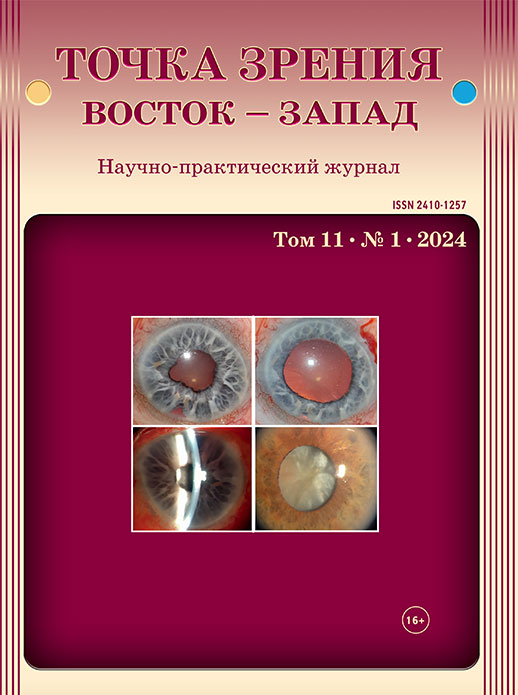Современные алгоритмы терапии диабетического макулярного отека (Обзор литературы. Часть II)
Ключевые слова:
диабетическая ретинопатия, диабетический макулярный отек, фактор роста эндотелия сосудов, VEGF-терапияАннотация
В обзоре представлена современная информация об официально разрешенных интравитреальных ингибиторах ангиогенеза, дана сравнительная характеристика результатов проводимых крупных рандомизированных исследований по их эффективности и безопасности, а также возможным схемам их введения. Отдельное внимание уделено проблеме рефрактерного диабетического макулярного отека и альтернативным методам его лечения, включающим применение глюкокортикоидов, ингибирование Rho/ROCK-сигнального пути. Динамика толщины центральной зоны сетчатки по данным оптической когерентной томографии и максимальная корригированная острота зрения являются основными критериями для оценки эффективности терапии диабетического макулярного отека. Согласно современным данным, интравитреальное введение ингибиторов ангиогенеза является лечением первой линии. При диабетическом макулярном отеке в России зарегистрированы следующие препараты: ранибизумаб, афлиберцепт, бролуцизумаб, фарицимаб. Лазерная фотокоагуляция сетчатки применяется в основном для лечения нецентрального отека. В качестве альтернативной терапии рассматриваются интравитреальные глюкокортикоиды, но их применение ограничено наличием побочных эффектов в виде вторичной медикаментозно-индуцированной офтальмогипертензии и/или глаукомы и развитием катаракты. Однако нежелательная реакция на стандартное лечение и развитие рефрактерных форм стимулируют разработку новых препаратов и систем доставки, а также использование нескольких типов терапии, воздействующих на различные точки патогенеза заболевания.
Библиографические ссылки
1. Furino C, Boscia F, Reibaldi M, Alessio G. Intravitreal Therapy for Diabetic Macular Edema: An Update. J. Ophthalmol. 2021;2021: 6654168. doi: 10.1155/2021/6654168
2. Курышева Н.И., Сергушев С.Г., Наумова В.И., Иванова А.А. Эволюция применения ингибиторов ангиогенеза в офтальмологии. Эффективная фармакотерапия. 2022;18(11): 58–67. [Kurysheva NI, Sergushev SG, Naumova VI, Ivanova AA. Evolution of the Use of Angiogenesis Inhibitors in Ophthalmology. Effective pharmacotherapy. 2022;18(11): 58–67. (In Russ.)] doi: 10.33978/2307-3586-2022-18-11-58 67
3. Астахов Ю.С., Нечипоренко П.А. Режимы назначения ингибиторов ангиогенеза при лечении пациентов с неоваскулярной возрастной макулярной дегенерацие. Офтальмологические ведомости. 2019;12(2): 47–56. [Astakhov YuS, Nechiporenko PA. Dosing regimens of angiogenesis inhibitors in the treatment of neovascular age-related macular degeneration patients. Ophthalmology Journal. 2019;12(2): 47–56. (In Russ.)] doi: 10.17816/OV12247-56
4. Lanzetta P, Loewenstein A, Vision Academy Steering Committee Fundamental principles of an anti-VEGF treatment regimen: optimal application of intravitreal anti-vascular endothelial growth factor therapy of macular diseases. Graefes Arch Clin Exp Ophthalmol. 2017;255: 1259–1273. doi: 10.1007/s00417-017-3647-4
5. Chatziralli I. Ranibizumab for the treatment of diabetic retinopathy. Expert Opin Biol Ther. 2021;21(8): 991–997. doi: 10.1080/14712598.2021.1928629
6. Nguyen QD, Sepah YJ, Berger B, et al. Primary Outcomes of the VIDI Study: Phase 2, Double-Masked, Randomized, Active- Controlled Study of ASP8232 for Diabetic Macular Edema. Int J Retin. Vitr. 2019;5: 28. doi: 10.1186/s40942-019-0178-7
7. Schmidt-Erfurth U, Lang GE, Holz FG, et al. Three-year outcomes of individualized ranibizumab treatment in patients with diabetic macular edema: the RESTORE extension study. Ophthalmology. 2014;121(5): 1045–53. doi: 10.1016/j.ophtha.2013.11.041
8. Lai TT, Chen TC, Yang CH, et al. Treat-and-Extend vs. Pro Re Nata Regimen of Ranibizumab for Diabetic Macular Edema-A Two- Year Matched Comparative Study. Front Med (Lausanne). 2022;8: 781421. doi: 10.3389/fmed.2021.781421
9. Antoszyk AN, Tarnowski KW, Basu K, Ehrlich JS, Haskova Z. Ranibizumab in Diabetic Retinopathy with or without Diabetic Macular Edema. Ophthalmol Retina. 2020;4(10): 1034–1036. doi: 10.1016/j.oret.2020.05.020
10. Zucchiatti I, Bandello F. Intravitreal Ranibizumab in Diabetic Macular Edema: Long-Term Outcomes. Dev Ophthalmol. 2017;60: 63–70. doi: 10.1159/000460496
11. Chakravarthy U, Pearce I, Banerjee S, et al. Patient-reported outcomes in the RELIGHT clinical trial of ranibizumab in diabetic macular oedema. BMJ Open Ophthalmol. 2019;4(1): e000226. doi: 10.1136/bmjophth-2018-000226
12. Dervenis N, Mikropoulou AM, Tranos P, Dervenis P. Ranibizumab in the Treatment of Diabetic Macular Edema: A Review of the Current Status, Unmet Needs, and Emerging Challenges. Adv Ther. 2017;34(6): 1270–1282. doi: 10.1007/s12325-017-0548-1
13. Holekamp N, Duff SB, Rajput Y, Garmo V. Cost-effectiveness of ranibizumab and aflibercept to treat diabetic macular edema from a US perspective: analysis of 2-year Protocol T data. J Med Econ. 2020;23(3): 287–296. doi: 10.1080/13696998.2019.1666855
14. Ranade SV, Wieland MR, Tam T, et al. The Port Delivery System with ranibizumab: a new paradigm for long-acting retinal drug delivery. Drug Deliv. 2022;29(1): 1326–1334. doi: 10.1080/10717544.2022.2069301
15. Campochiaro PA, Marcus DM, Awh CC, et al. The Port Delivery System with Ranibizumab for Neovascular Age-Related Macular Degeneration: Results from the Randomized Phase 2 Ladder Clinical Trial. Ophthalmology. 2019;126(8): 1141–1154. doi: 10.1016/j.ophtha.2019.03.036
16. Glassman AR, Wells JA 3rd, Josic K, et al. Five-Year Outcomes after Initial Aflibercept, Bevacizumab, or Ranibizumab Treatment for Diabetic Macular Edema (Protocol T Extension Study). Ophthalmology. 2020;127(9): 1201–1210. doi: 10.1016/j.ophtha.2020.03.021
17. Santhakumaran S, Salimi A, Brunetti VC, Galic J. Efficacy and Safety of Aflibercept Therapy for Diabetic Macular Edema: A Systematic Review and Meta-Analysis. J Curr Ophthalmol. 2022;34(2): 133–147. doi: 10.4103/joco.joco_308_21
18. Ziemssen F, Schlottman PG, Lim JI, et al. Initiation of intravitreal aflibercept injection treatment in patients with diabetic macular edema: a review of VIVID-DME and VISTA-DME data. Int J Retina Vitreous. 2016;2: 16. doi: 10.1186/s40942-016-0041-z
19. Mitchell P, McAllister I, Larsen M, et al. Evaluating the Impact of Intravitreal Aflibercept on Diabetic Retinopathy Progression in the VIVID-DME and VISTA-DME Studies. Ophthalmol Retina. 2018;2(10): 988–996. doi: 10.1016/j.oret.2018.02.011
20. Jhaveri CD, Glassman AR, Ferris FL 3rd, et al. Aflibercept Monotherapy or Bevacizumab First for Diabetic Macular Edema. N Engl J Med. 2022;387(8): 692–703. doi: 10.1056/NEJMoa2204225
21. Hirano T, Kumazaki A, Tomihara R, et al. Evaluating initial responses to brolucizumab in patients undergoing conventional anti-VEGF therapy for diabetic macular edema: a retrospective, single-center, observational study. Sci Rep. 2023;13(1): 10901. doi: 10.1038/s41598-023 37726-5
22. Brown DM, Emanuelli A, Bandello F, et al. KESTREL and KITE: 52-Week Results From Two Phase III Pivotal Trials of Brolucizumab for Diabetic Macular Edema. Am J Ophthalmol. 2022;238: 157–172. doi: 10.1016/j.ajo.2022.01.004
23. Wykoff CC, Garweg JG, Regillo C, et al. KESTREL and KITE Phase 3 studies: 100-week results with brolucizumab in patients with diabetic macular edema. Am J Ophthalmol. 2023;S0002-9394(23): 00291-X. doi: 10.1016/j.ajo.2023.07.012
24. Nicolò M, Ferro Desideri L, Vagge A, Traverso CE. Faricimab: an investigational agent targeting the Tie-2/angiopoietin pathway and VEGF-A for the treatment of retinal diseases. Expert Opin Investig Drugs. 2021;30(3): 193–200. doi: 10.1080/13543784.2021.1879791
25. Rush RB, Rush SW. Faricimab for Treatment-Resistant Diabetic Macular Edema. Clin Ophthalmol. 2022;16: 2797–2801. doi: 10.2147/OPTH.S381503
26. Sahni J, Patel SS, Dugel PU, et al. Simultaneous Inhibition of Angiopoietin-2 and Vascular Endothelial Growth Factor-A with Faricimab in Diabetic Macular Edema: BOULEVARD Phase 2 Randomized Trial. Ophthalmology. 2019;126(8): 1155–1170. doi: 10.1016/j.ophtha.2019.03.023
Akwii RG, Sajib MS, Zahra FT, Mikelis CM. Role of Angiopoietin-2 in Vascular Physiology and Pathophysiology. Cells. 2019;8(5): 471. doi: 10.3390/cells8050471
28. Sharma A, Kumar N, Kuppermann BD, Bandello F, Loewenstein A. Faricimab: expanding horizon beyond VEGF. Eye (Lond). 2020;34(5): 802–804. doi: 10.1038/s41433-019-0670-1
29. Wykoff CC, Abreu F, Adamis AP, et al. Efficacy, durability, and safety of intravitreal faricimab with extended dosing up to every 16 weeks in patients with diabetic macular oedema (YOSEMITE and RHINE): two randomised, double-masked, phase 3 trials. Lancet. 2022;399(10326): 741–755. doi: 10.1016/S0140-6736(22)00018-6
30. Bressler NM, Beaulieu WT, Glassman AR, et al. Persistent Macular Thickening Following Intravitreous Aflibercept, Bevacizumab, or Ranibizumab for Central-Involved Diabetic Macular Edema with Vision Impairment a Secondary Analysis of a Randomized Clinical Trial. JAMA Ophthalmol. 2018;136: 257–269. doi: 10.1001/ jamaophthalmol.2017.6565
31. Madjedi K, Pereira A, Ballios BG, et al. Switching between anti-VEGF agents in the management of refractory diabetic macular edema: A systematic review. Surv Ophthalmol. 2022;67(5): 1364–1372. doi: 10.1016/j.survophthal.2022.04.001
32. Estebainha R, Goldhardt R, Falcão M. A New Approach for Diabetic Macular Edema Treatment: Review of Clinical Practice Results with 0.19 Mg Fluocinolone Acetonide Intravitreal Implant Including Vitrectomized Eyes. Curr. Ophthalmol. Rep. 2020;8: 1–10. doi: 10.1007/s40135-020-00225-1
33. Iglicki M, Busch C, Zur D, Okada M, et al. Dexamethasone Implant for Diabetic Macular Edema in Naive Compared with Refractory Eyes: The International Retina Group Real-Life 24-Month Multicenter Study: The Irgrel-Dex Study. Retina. 2019;39: 44–51. doi: 10.1097/IAE.0000000000002196
34. Castro-Navarro V, Cervera-Taulet E, Navarro-Palop C, et al. Intravitreal Dexamethasone Implant Ozurdex® in Naïve and Refractory Patients with Different Subtypes of Diabetic Macular Edema 11 Medical and Health Sciences 1103 Clinical Sciences. BMC Ophthalmol. 2019;19: 15. doi: 10.1186/s12886-018-1022-9
35. Chawan-Saad J, Wu M, Wu A, Wu L. Corticosteroids for Diabetic Macular Edema. Taiwan J. Ophthalmol. 2019;9: 233–242. doi: 10.4103/tjo.tjo_68_19
36. Таскина Е.С., Харинцева С.В., Просекина Е.В. Медикаментозно-индуцированная (стероидная) офтальмогипертензия и глаукома. Забайкальский медицинский вестник. 2022;4: 122–131. [Taskina ES, Kharintseva SV, Prosekina EV. Drug-induced (steroid) ophthalmohypertension and glaucoma. Zabaikalsky meditsinskii vestnik. 2022;4: 122–131. (In Russ.)] doi: 10.52485/19986173_2022_4_122
37. Mateos-Olivares M, García-Onrubia L, Valentín-Bravo FJ, et al. Rho-Kinase Inhibitors for the Treatment of Refractory Diabetic Macular Oedema. Cells. 2021;10(7): 1683. doi: 10.3390/ cells10071683
38. Jahani V, Kavousi A, Mehri S, Karimi G. Rho Kinase, a Potential Target in the Treatment of Metabolic Syndrome. Biomed. Pharmacother. 2018;106: 1024–1030. doi: 10.1016/j.biopha. 2018.07.060
39. Koch JC, Tatenhorst L, Roser AE, et al. ROCK Inhibition in Models of Neurod egeneration and Its Potential for Clinical Translation. Pharmacol. Ther. 2018;189: 1–21. doi: 10.1016/j. pharmthera.2018.03.008
40. Nourinia R, Nakao S, Zandi S, et al. ROCK Inhibitors for the Treatment of Ocular Diseases. Br. J. Ophthalmol. 2018;102. doi: 10.1136/bjophthalmol-2017-310378
41. Mateos-Olivares M, García-Onrubia L, Valentín-Bravo FJ, et al. Rho-Kinase Inhibitors for the Treatment of Refractory Diabetic Macular Oedema. Cells. 2021;10(7): 1683. doi: 10.3390/cells10071683
42. Ahmadieh H, Nourinia R, Hafezi-Moghadam A, et al. Intravitreal Injection of a Rho-Kinase Inhibitor (Fasudil) Combined with Bevacizumab versus Bevacizumab Monotherapy for Diabetic Macular Oedema: A Pilot Randomised Clinical Trial. Br. J. Ophthalmol. 2019;103: 922–927. doi: 10.1136/ bjophthalmol-2018-312244



